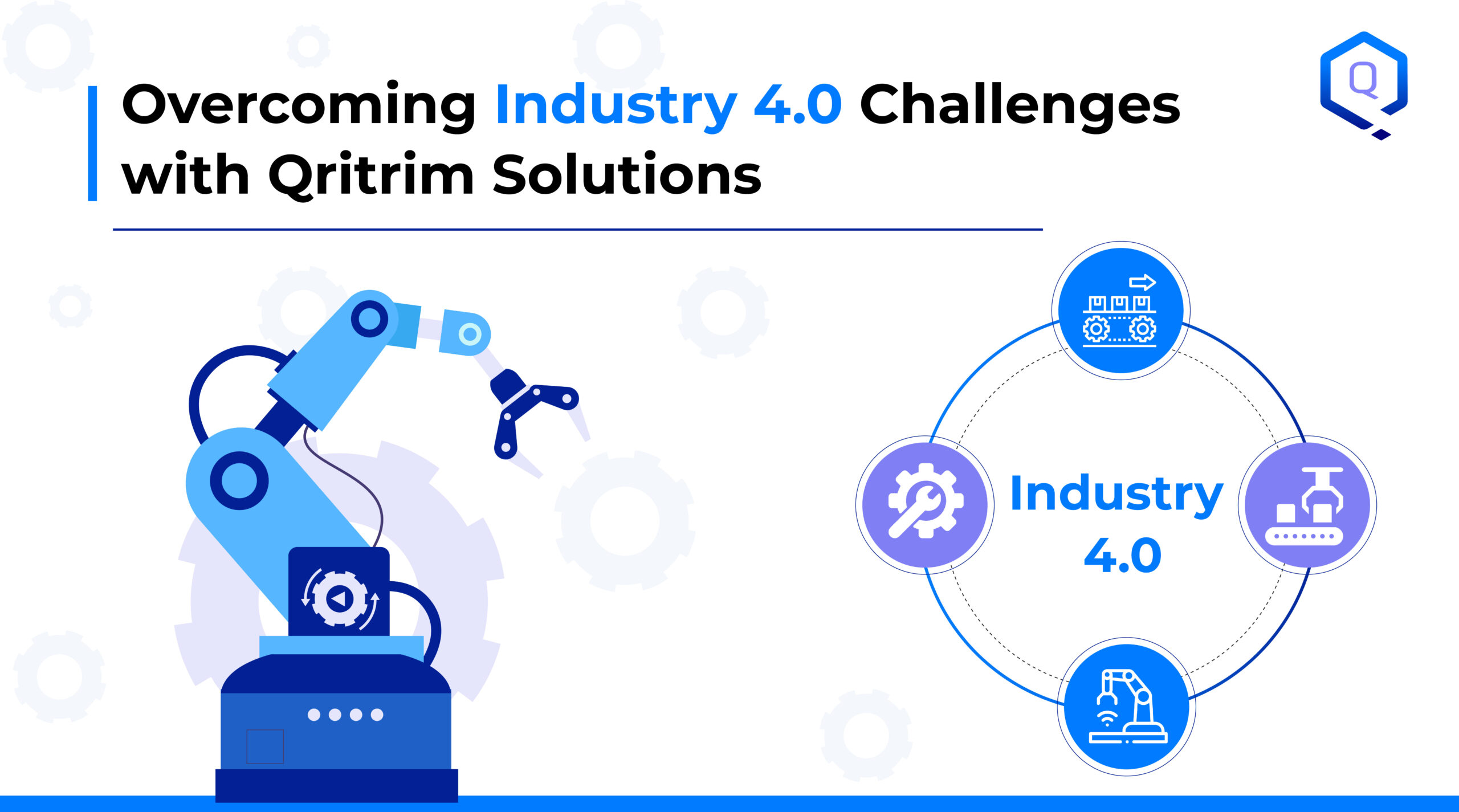The combination of technology and manufacturing is reshaping the way we create, build, and innovate. Industry 4.0 is all about smart factories. It is like machines talk to each other and share data with human workers. Which promises increased efficiency, improved product quality, faster production, and a reduced environmental footprint. However, within the charm of these advantages lies an array of challenges and risks. And yes, companies do grapple with these challenges during their journey towards this new industrial frontier. In this blog, let us discuss the most important challenges.
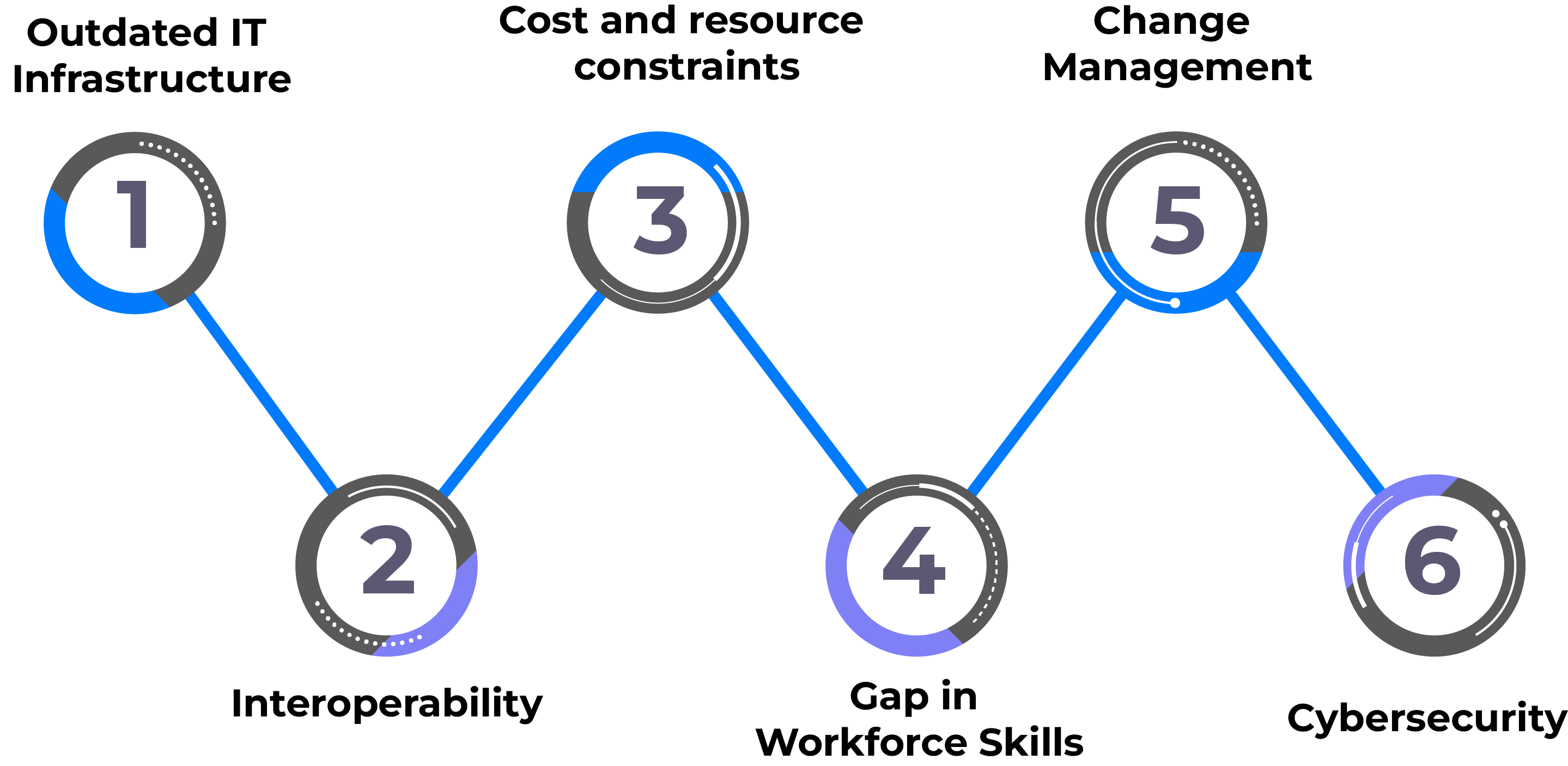
Outdated IT Infrastructure:
One of the main hurdles to embracing Industry 4.0 is outdated IT systems. Yes. The legacy infrastructure. Existing technological infrastructure in many companies will be incompatible with the integration of new software aimed at analyzing production data. Updating these systems is time-consuming. It is also an intricate process and demands a comprehensive analysis of the current state of business management systems across various operational domains.
How can we address this challenge?
Before embarking on the journey to a smart factory, it’s crucial to lay solid IT groundwork. This can involve:
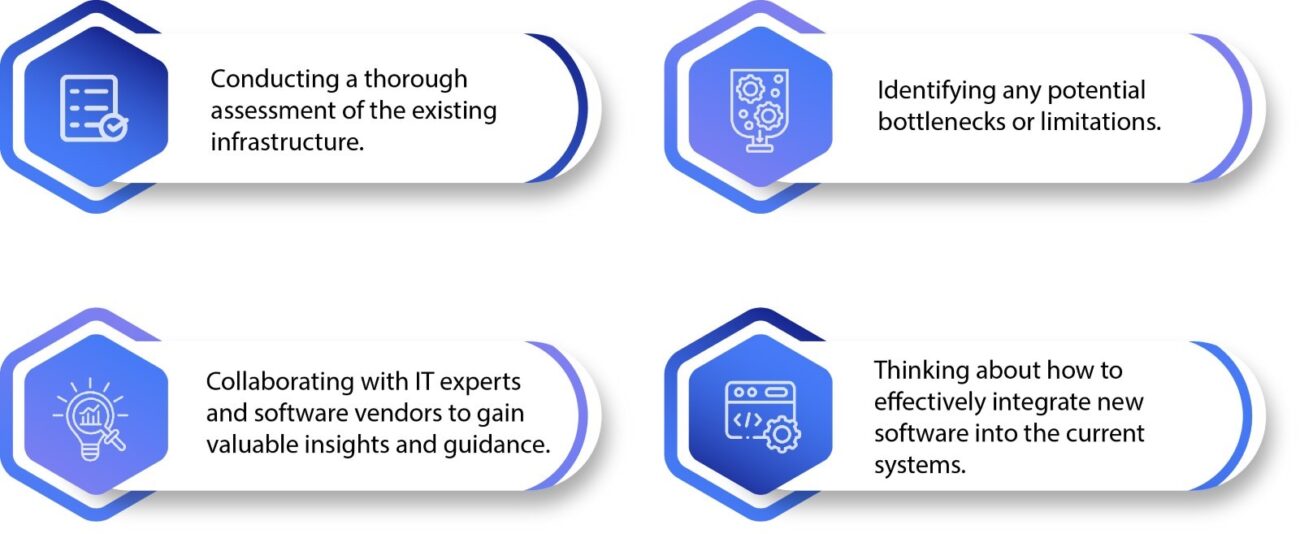
By taking these steps, companies can minimize disruption and ensure the successful implementation of production data analysis software in their operations.
Interoperability:
Interoperability hurdles arise from the coexistence of legacy and modern equipment. Older machines lack sensor integration and network connectivity, which are essential for smart factory operations. Replacing everything isn’t always viable because it causes a data communication gap and hinders progress.
How can we address this challenge?
Overcoming this challenge requires:
- Implementing an integration software
- Investing in systems capable of evaluating data from connected machines.
- Maintaining a seamless flow of production planning and execution information is essential to align with the approach of connected manufacturing.
Additionally, implementing retrofitting solutions can help bridge the gap between older machinery and smart factory operations. Retrofitting involves adding sensors and connectivity features to existing machinery, enabling them to communicate and share data with other machines on the production line. This approach allows manufacturers to gradually upgrade their equipment without incurring the cost of a complete replacement. By embracing integration software and retrofitting solutions, manufacturers can achieve interoperability and ensure a smooth flow of data throughout their manufacturing processes.
Cost and resource constraints:
Implementing Industry 4.0 technologies requires substantial investments in making IoT systems harmonious with existing manufacturing control systems. The variation in technology standards compounds this issue, and limitations on technology investment further delay scaling Industry 4.0 projects.
How can we address this challenge?
- Adopting a minimum viable product approach to prioritize the most critical aspects of their Industry 4.0 projects and start implementing them incrementally.
- A more agile and iterative development process, reducing the initial investment required and providing early benefits while still refining the overall IT architecture.
- Collaborate with technology vendors and industry experts to deal with the complex landscape of technology standards to ensure that investments are made in the most compatible and scalable solutions.
Gap in Workforce Skills:
Next generation of artificial intelligence and automation in manufacturing will change factory production functions by improving analytics and increasing human-machine collaboration. It will have an impact on product development, marketing, and sales. The overall demand for physical and manual skills in the manufacturing industry is dropping at a rate more than double that of the broader economy. The demand for fundamental cognitive skills is also decreasing as office support jobs are mechanized. Sales agents, engineers, managers, and executives are predicted to increase. This will increase the demand for social and emotional abilities, particularly sophisticated communication and negotiation, leadership, management, and flexibility. As more technology experts are required, there will be a greater demand for technological abilities, including advanced IT skills and basic digital skills. Demand for higher cognitive skills will rise due to increased creativity and complicated information processing. The transition to Industry 4.0 necessitates a workforce with digital proficiency, a need that frequently exceeds the skill set that many employees already possess. From operating touch screens and portable computing devices to interpreting data-backed insights, there is a compelling need for a reskilling revolution.
How can we address this challenge?
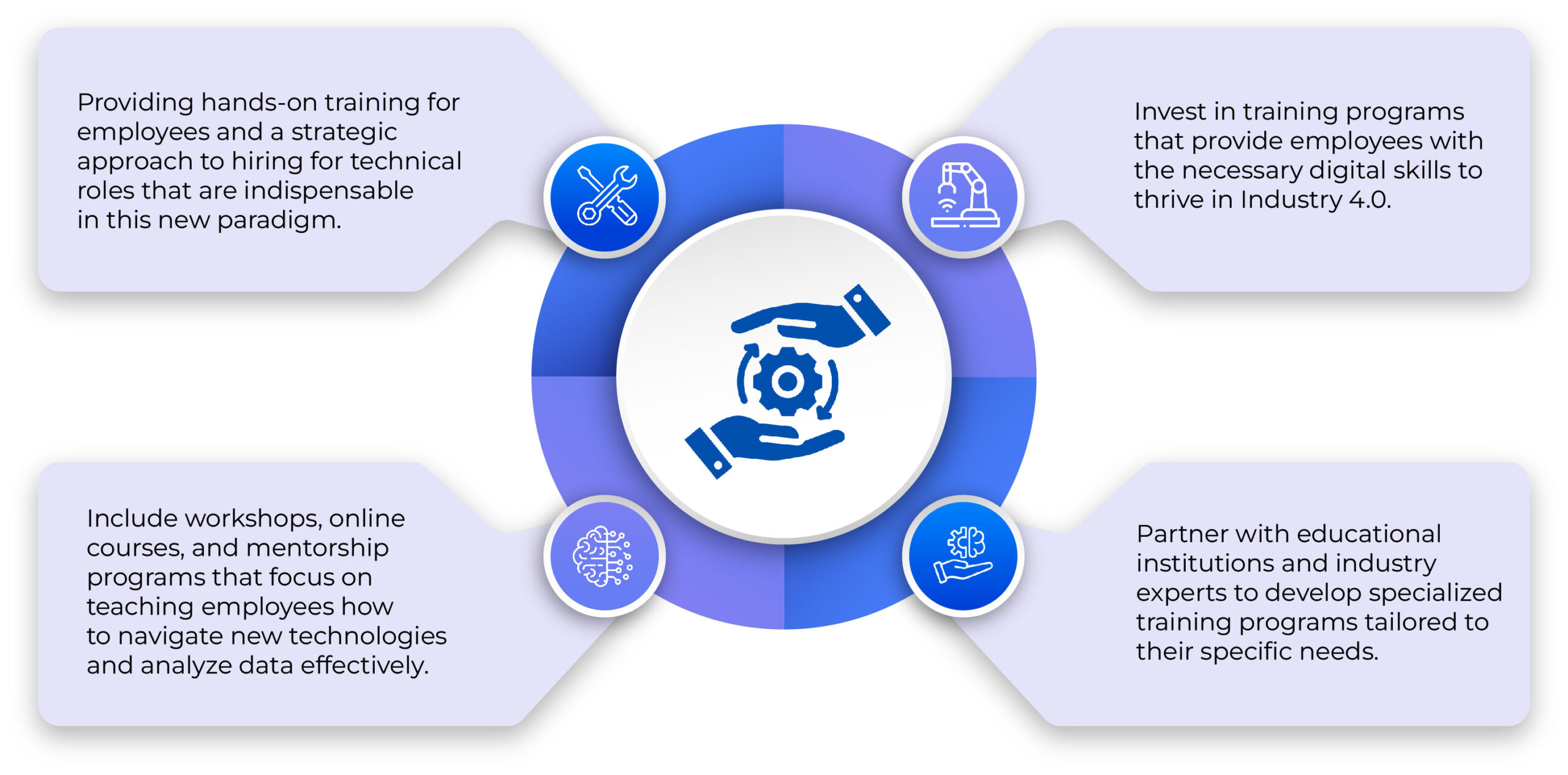
By combining these efforts with a targeted recruitment strategy for technical roles, companies can build a workforce that is equipped to handle the demands of Industry 4.0 and drive innovation forward.
Change Management:
Adopting Industry 4.0 goes beyond the shop floor, necessitating an organizational understanding of where processes need to change. Establishing this awareness and coordinating inter-departmental collaboration represents a formidable change management challenge.
How can we address this challenge?
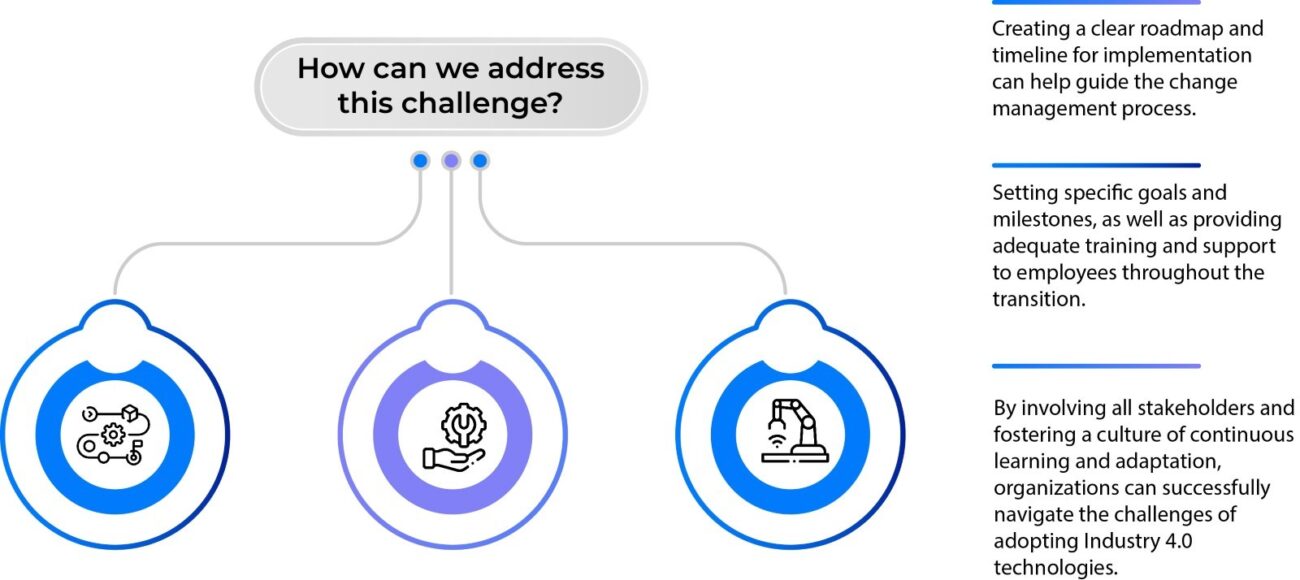
Cybersecurity:
The interconnection of machines and connectivity in Industry 4.0 paves the way for heightened cybersecurity risks. The traditional approach of safeguarding factory equipment against cyber threats becomes outdated in this era of connected machines.
How can we address this challenge?
- Embrace cloud computing.
- Establish private LTE and 5G networks to strengthen cybersecurity and mitigating risks in Industry 4.0 is by implementing robust authentication and encryption protocols to secure data Invest in advanced threat detection and response systems that continuously monitor network activity and quickly identify any potential cyber threats.
Embracing the Renaissance
Embracing Industry 4.0 is like embarking on an exciting journey where we tackle challenges using a mix of smart ideas, careful planning, and a strong commitment to exploring new territory. Companies are getting ready to overcome old computer systems, compatibility issues, and the need to train their workforce for new skills. It’s like we’re at the forefront of creating a new era in industry, a rebirth or renaissance.
Dealing with Industry 4.0 isn’t just about solving problems – it’s about using those challenges as stepping stones to a future where things work better, are more sustainable, and where new ideas thrive.
To sum it up, Industry 4.0 isn’t just a fancy phase in technology – it’s proof of how determined and resilient we are as humans. As we face these challenges, we’re not just reaching new heights; we’re paving the way for a future that’s both high-tech and caring. Think of it as a story where problems become chances to do something great, and where being creative is how we make things better. Welcome to Industry 4.0 – a world where challenges open up new possibilities, and every roadblock is a chance to evolve and reinvent.
With strong determination and creative thinking, we’re diving into the challenges of Industry 4.0 and welcoming a new era. It’s like weaving together technology and human effort to create a story that’s both classic and transformative.
Overcoming Industry 4.0 Challenges with Qritrim
- Outdated IT: By leveraging Qritrim’s innovative technology, businesses can modernize their IT infrastructure without the need for a complete overhaul. This allows for a gradual and cost-effective transition to Industry 4.0, ensuring a smooth integration of new systems while maximizing efficiency and productivity.
- Data Silos: With Qritrim, businesses can eliminate data silos and achieve seamless communication between different equipment. By translating and unifying data, Qritrim ensures that there are no more information gaps, enabling businesses to make informed decisions and optimize their operations. This not only improves efficiency but also paves the way for a successful transition to Industry 4.0.
- Cost Concerns: Qritrim understands the importance of cost concerns for businesses. By offering solutions that provide high returns on investment, businesses can start small and gradually scale up as they gain confidence in the technology. This approach ensures that businesses do not have to break the bank to implement Qritrim’s solutions and can see results quickly, further enhancing their productivity and efficiency.
- Workforce Skills: With Qritrim’s ongoing learning resources, businesses can bridge the skills gap within their workforce. This empowers employees to confidently embrace new technologies, increasing their productivity and efficiency. Additionally, by investing in workforce skills development, businesses can future-proof their teams and stay ahead of industry trends.
- Change Resistance: Qritrim helps you communicate the benefits clearly, involve all stakeholders, and track progress every step of the way. By addressing change resistance, businesses can minimize disruptions and ensure a smooth transition to new technologies. Qritrim’s comprehensive approach helps businesses effectively communicate the benefits of change, involve all stakeholders in the process, and track progress to ensure successful implementation. This ultimately leads to increased adoption rates and a more positive work environment.
- Cybersecurity Threats: Stay ahead of the game. Qritrim’s secure solutions safeguard your data with multiple layers of protection and keep you compliant with industry standards. By proactively addressing cybersecurity threats, businesses can mitigate the risk of data breaches and protect their sensitive information. Qritrim’s secure solutions not only provide robust protection against evolving cyber threats but also offer regular updates and monitoring to stay ahead of potential vulnerabilities. This enables businesses to maintain a strong security posture and instill confidence in their customers, partners, and employees.
With Qritrim as your partner, Industry 4.0 challenges become stepping stones to a future of enhanced efficiency, innovation, and sustainable success. Let’s rewrite the story of industry together.























